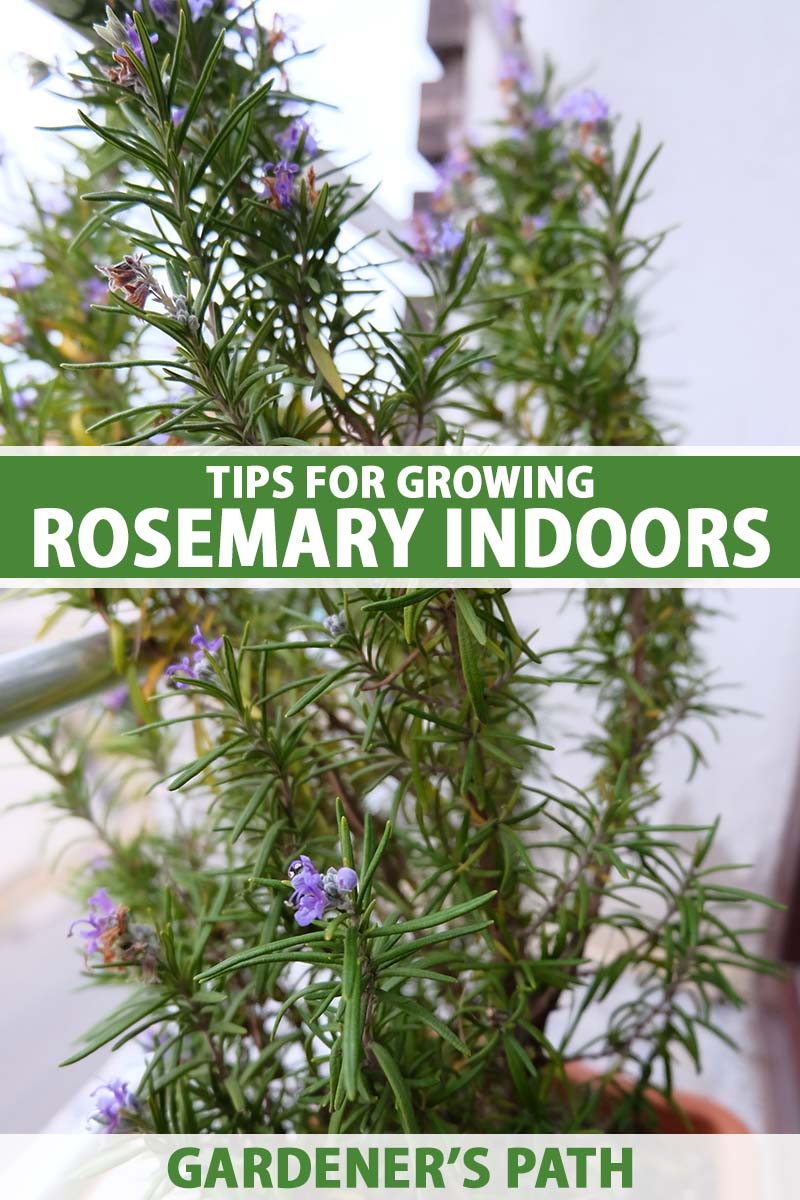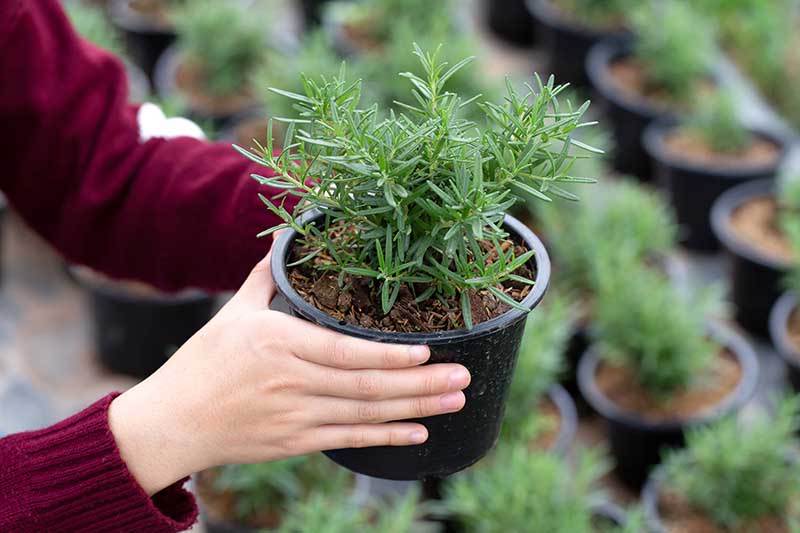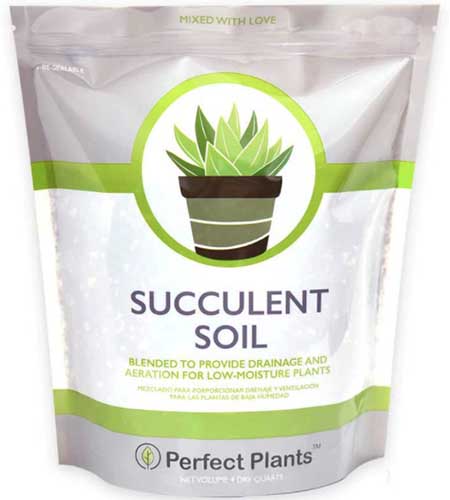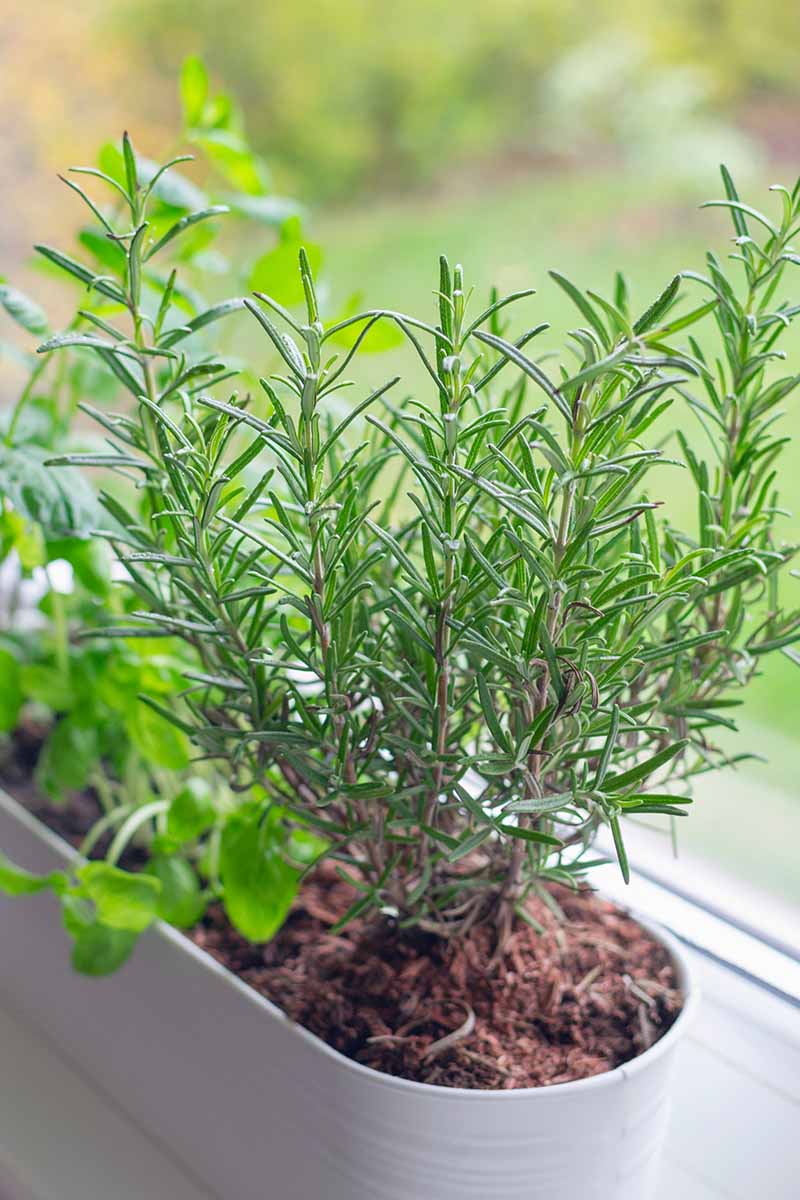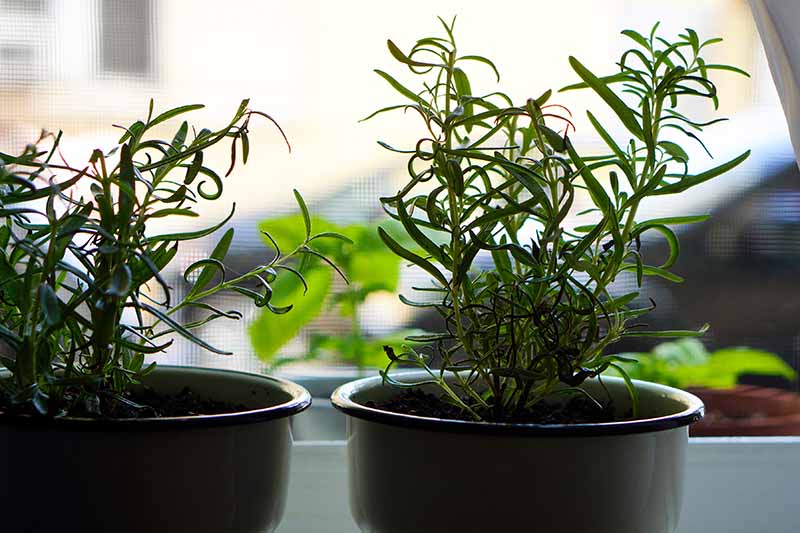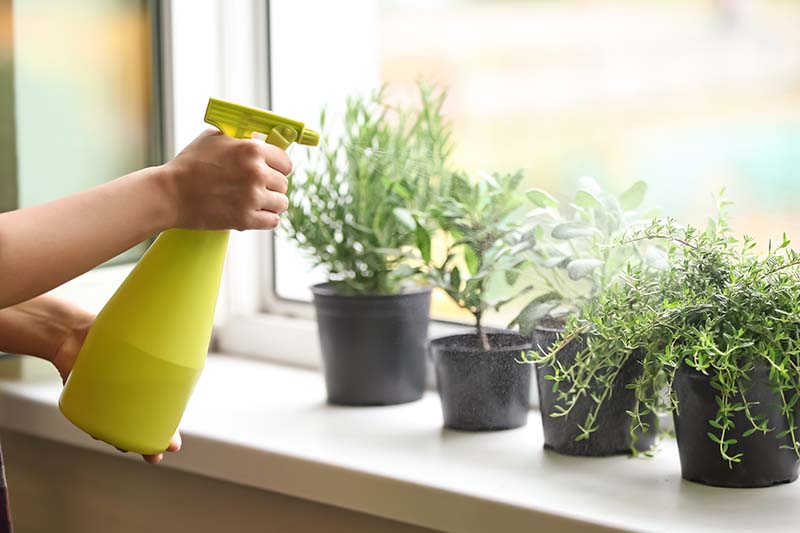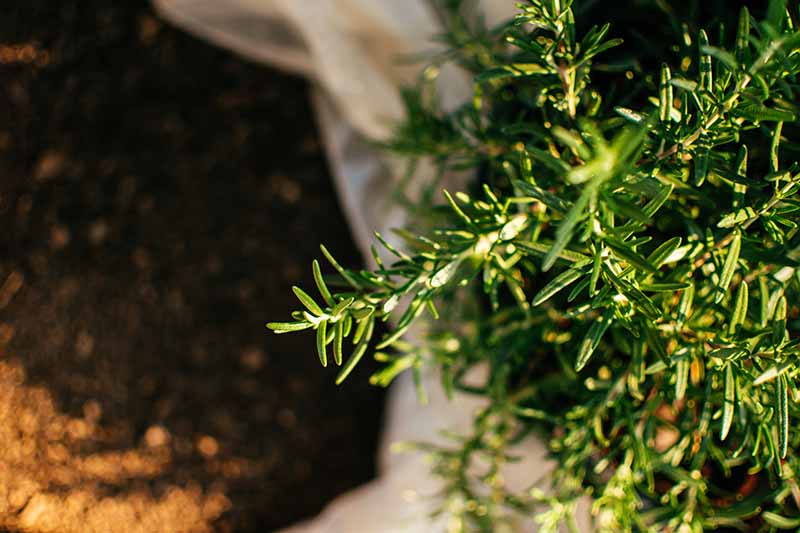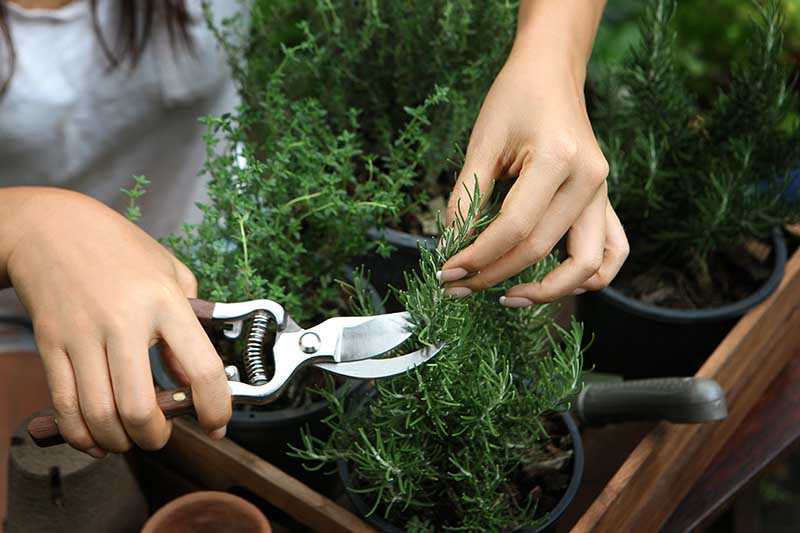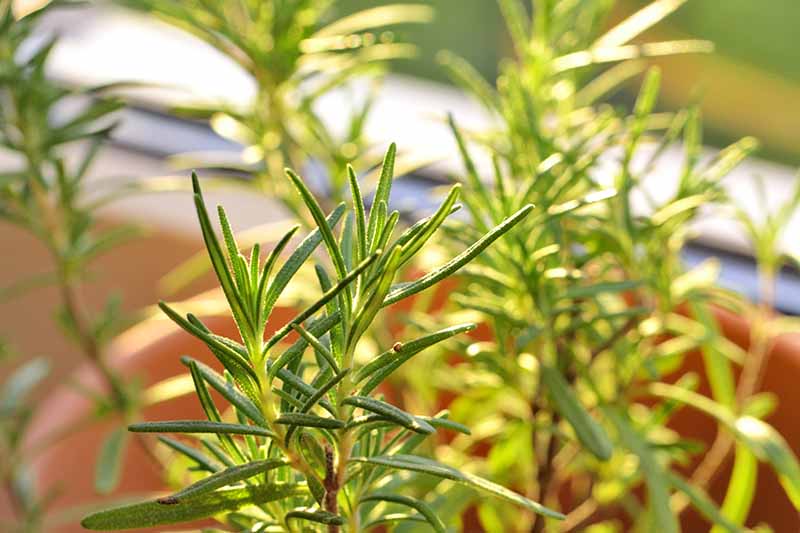With its spicy-sweet flavor, pungent aroma, and pretty, needle-like leaves, this shrub in the mint family, Lamiaceae, can bring good cheer to your home as an herbaceous houseplant that keeps on giving. We link to vendors to help you find relevant products. If you buy from one of our links, we may earn a commission. Thankfully, it’s pretty easy to keep rosemary happy as long as you follow the tips we’re about to share. Here’s what you need to know:
Getting Started
To get started, choose a container that’s six to eight inches wide and deep, or a little larger if you prefer. S. rosmarinus can grow to be about two to four feet tall and may spread one to four feet, depending on the cultivar, but it’s a slow-growing plant that’s easy to keep more compact, especially when you plant it in a pot. The container can be made of any material you like. The most important characteristic of whatever pot you choose is that it has drainage holes, because rosemary does not do well in soggy, poorly draining soil.
Planting
Once you’ve got everything ready, it’s easy to transplant your rooted cutting, seedling, or potted nursery plant to your waiting container. Ceramic Planter I love this stylish eight-inch ceramic pot from the Home Depot. Find a pot with a detachable drainage dish if you can, and make sure you regularly dump out any standing water that’s left in the dish, to prevent your plants from getting soggy roots. Perfect Plants Succulent Mix Fill your container with well-draining potting soil, like this succulent mix from Perfect Plants, available at the Home Depot. Rosemary likes light humidity, which can be tricky to achieve inside a home. Most homes usually have dry air, especially when the heat is running. Consider setting the container on a dish filled with pebbles to provide additional humidity. You’ll fill the tray with water to keep the air around the herb slightly moist as it evaporates, and add more water as needed. Lightly mist the leaves once a day with water from a spray bottle as well. Rosemary does best with 45 to 55 percent ambient humidity. Digital Hygrometer Next, it’s time to find a plant to grow at home. Propagating rosemary from cuttings is the easiest thing to do. You can learn more about rooting stem cuttings in our guide to propagating rosemary, which includes tips for starting plants from seed or via layering as well. Or, you can purchase a rooted plant at a garden center in person or online. Note that growing this herb from seed takes the longest amount of time of all the available propagation methods, and germination rates can be low. But this can be a fun challenge for indoor gardeners who are up for it. Rosemary Nursery Starts You can find a set of three plants online from Burpee. This variety grows 24 to 36 inches tall and spreads just 12 to 24 inches, making it ideal for growing indoors in containers. Gently ease the root ball out of the container and move the plant into its new home. As a general rule of thumb, there should be at least an inch of space between the sides of the container and the root ball. If you find that the root ball doesn’t have enough space, you may need to choose a slightly larger container instead. Add a bit more potting mix to cover the entire root ball while also making sure that the stem isn’t covered. Leave about two inches of space between the rim of the container and the surface of the potting mix. Give the plant a good soaking, letting the water drain out into the saucer below before dumping the excess, and set it in a bright, sunny windowsill.
Caring for Your Plant
If you don’t get at least six to eight hours of sunlight through a window, or if your plant begins to drop leaves and starts to look spindly and brown, you may need to put it under a grow light for 12 to 14 hours a day instead. Keep the light one inch away from the leaves at the top of the plant. Water your plant deeply, as needed. This may be every few days during hotter times of year, or once every week to ten days in the winter, for example. Deciding when to water all depends on how long it takes for the top half inch of soil to dry out. Use your finger or a moisture meter to check. Keep in mind that while rosemary likes some humidity, it doesn’t appreciate an overwhelming amount. If you live in a home that’s sticky with humidity, make sure there’s an open window or a fan running for a few hours a day to improve air circulation. Also, don’t let it get too hot: rosemary prefers an indoor temperature between 55 and 80°F. Fertilize the plant once a year in the spring with a balanced 10-10-10 (NPK) fertilizer, according to package instructions. Every two or three years, you’ll want to either repot your S. rosmarinus into a larger container, or remove the root ball and trim the roots to prevent it from becoming rootbound, and to keep it on the small side. Rosemary’s health starts to decline quickly when the roots aren’t efficiently drawing moisture and nutrients up from the soil. To trim the roots, carefully remove the root ball and clip off the bottom third with a clean pair of scissors or garden shears. Then, make two vertical cuts about an inch in from the sides of the root ball, starting at the bottom of the root ball and working about one-third of the way up. Repot the plant with fresh potting mix and water thoroughly. In addition to repotting every couple of years, you’ll want to trim away any broken branches. And remember to take a few sprigs every week or so for your soups and stews, too! This helps to maintain the plant’s shape, and to encourage bushier growth. If the herb blooms indoors, you can just enjoy the pretty sight – and then toss the edible blooms into your favorite salad. A flowering plant won’t negatively alter the flavor of your herb, and after a brief blooming period, the faded flowers may be deadheaded if you don’t wish to consume them.
Growing Tips
Choose a container that’s at least six to eight inches in diameter.Plant in well-draining potting soil or succulent mix.Water plants once or twice a week and spray once daily.Fertilize with a balanced 10-10-10 NPK fertilizer once a year in the spring.Repot or trim roots every two to three years.
Pests and Disease
Rosemary isn’t bothered much by pests or disease – even less so when you’re growing it inside. For tips on how to deal with the few issues that can pop up, see our guide to growing rosemary. Though rare, you may see aphids, spider mites, or whiteflies. Powdery mildew is a common problem if you’ve increased the humidity a bit too much, and failed to provide adequate airflow. Root rot can occur in cases of overwatering, or if plants are potted in containers with poor drainage.
Harvesting
Hands down, this herb is one of the easiest plants to harvest. First, wait until the plant grows several eight-inch-long branches. This signals that it’s ready to be harvested and will handle the trimming well. Here’s how to do it: Take a pair of clean, sharp scissors and cut two- to three-inch sprigs from the tops of the eight-inch-long branches whenever the need for some flavor strikes. Don’t take too much at once, though — always leave three-quarters of the leaves intact, taking just one-quarter of the plant at a time or less for your meals. Chop the leaves up to use in recipes after removing them from the stems, or tie the sprigs together with twine and hang them up to dry for about 10 days. Then, remove them from the stems for use as a dried seasoning. You can store the dried herbs in a mason jar in a cool, dry place, making sure to seal it tight after each use, and they’ll stay fresh and flavorful for up to six months. Find more tips on drying herbs in this guide.
Cooking and Recipe Ideas
One of my favorite ways to use this herb is to sprinkle freshly chopped needles into potato soup. You can also sprinkle rosemary on a salad, combine it with fish and poultry dishes, and use it to flavor olive oil. Try using this recipe from our sister site, Foodal to make the perfect rosemary-infused oil. Or try this easy recipe for chicken with rosemary and mushrooms, also from Foodal, for a comforting and satisfying weeknight entree. You could also make these delicious rosemary roasted, honey glazed carrots, also from Foodal, for the perfect healthy side dish to pair with just about any entree. Combine it with other houseplants and herbs for yearlong greenery, and enjoy a sprig in your cooking whenever you want. Have you ever grown S. rosmarinus indoors? Let us know in the comments below. As always, feel free to share thoughts or ask any questions you may have. We love to hear from you! And for more information on growing rosemary, put these guides on your reading list next:
Tips for Growing Rosemary in ContainersThe Best Cold Hardy Rosemary VarietiesHow to Protect Rosemary Plants in the Winter
